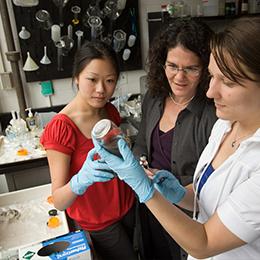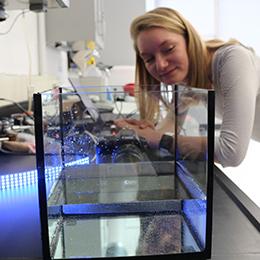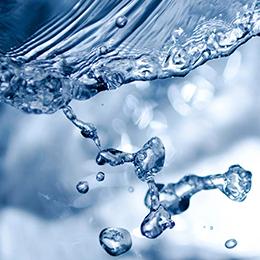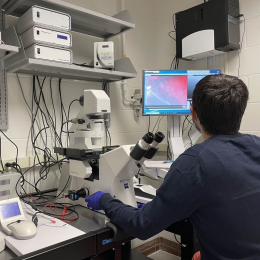
Environmental Processes Laboratories
In addition to highly versatile, sensor-enabled teaching lab facilities, EP also has specialty research labs in the areas of applied microbiology, environmental chemistry, ecological engineering, and sustainable water treatment technologies.
EP lab equipment includes state-of-the art tools in molecular microbiology including PCR/qPCR, FISH and multiwall plate readers, advanced Raman Spectroscopy, automated liquid handling system, environmental mass spectrometry for sensitive analysis of organic molecules, gas chromatography with multiple detectors for the analysis of biogenic gases and volatile organic molecules, and infrastructure for laboratory-scale or pilot-scale testing of drinking water treatment processes.

Applied Microbiology Lab
To aid in the study of microbes of relevance to environmental engineers, the Applied Microbiology Lab has a range of equipment for culturing aerobic and anaerobic microbial cultures. This includes constant temperature rooms, anaerobic glove boxes, anaerobic gassing stations, and laminar flow hoods for asceptic work. Equipment for DNA and RNA analysis include gel electrophoresis apparati, a nanoDrop machine, a Bioanalyzer, and PCR and quantitative PCR machines. Microscopes with Fluorescence capabilities enable direct observation of microbial cells with specific features and/or of specific microbial groups.
General EP labs: Analytical equipment includes various Gas Chromatographs (with Thermal Conductivity and Flame Ionization Detectors) plate readers with spectrophotometric, fluorescence, and luminescence detectors and incubation capabilities.

Ecological Engineering Laboratory
The Ecological Engineering Laboratory is equipped with analytical instruments to characterize gaseous and aqueous components of soil-water systems. A gas chromatograph with flame ionization, thermal conductivity, and electron capture detectors supports analysis of biogenic gases (methane, nitrous oxide, carbon dioxide, hydrogen) as well as conservative gas tracers including sulfur hexafluoride, helium, and argon. Aqueous analytes including major cations/anions, low molecular weight organic acids, and total organic carbon and nitrogen are measured using ion chromatography and total carbon/nitrogen analyzers. The lab also includes bench-scale models of engineered soil systems (e.g., constructed wetlands, infiltration basins) for controlled experiments of coupled biological and physiochemical processes in these systems. Standard wet chemistry lab items are also available.

Environmental Biotechnology Laboratory
The Environmental Biotechnology Laboratory is a newly renovated facility that serves as a stand-alone environmental laboratory geared towards molecular biology applications, housing state-of-art precision instruments critical to detailed microbiological and biotechnology research applications, as well as a full complement of chemicals and glassware along with two fume hoods. The main equipment include Raman Spectroscopy, fluorescence microscope, automated liquid handling systems for high-throughput bioassays, automated DNA extraction unit, quantitative qPCR machine, microplate readers, cell incubators and other environmental microbiology and molecular biology-related equipment.

Environmental Chemistry Lab
The Environmental Chemistry Lab is equipped for trace analysis of polar and semi-polar molecules in aquatic matrices. The featured instrument is a quadrupole-orbitrap high-resolution mass spectrometer (HR-MS) that enables sensitive quantitation and exploratory qualitative analyses aimed at discovering non-targeted chemicals in impacted environments or identifying intermediates of transformation processes. The HR-MS is paired with a standard HPLC system and an eaasyNano LC system and can be fit with electrospray ionization, atmospheric pressure chemical ionization, and nanospray sources. To support this research, a variety of complementary equipment is available including a separate HPLC-UV-Vis system with fraction collector for sample preparation, on-line and off-line solid phase extraction, and a variety of minor equipment including pH meters, sonication bath, analytical balances, microbalances, stir plates, a rototumbler, and other typical wet chemistry lab items.


